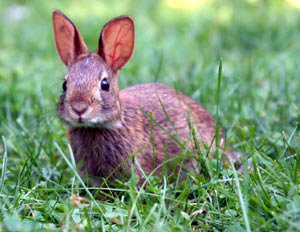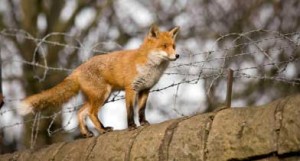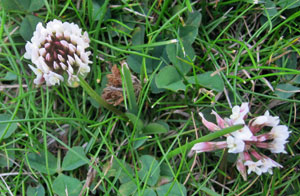The rabbit – an introduced species?

Whilst rabbit bones and teeth are found at various U.K. archaeological sites that date back to ‘warm’ inter-glacial periods, none have been found at Iron Age, Roman or even Anglo-Saxon sites. This suggests that the (European) rabbit did not survive the last Ice Age in the British Isles; therefore the rabbit is an introduced species (see previous blog / post).
The Romans imported domesticated rabbits but there is scant evidence that any Roman rabbits escaped to the countryside and established themselves. Apparently, there is no mention of the rabbit in the Domesday Book – which recorded most things!
The first references to the (European) rabbit being present in the British Isles were found by Veale (1957) and Sheail (1971). They found that rabbits were kept on the Scilly Isles, Lundy Island (in the Bristol Channel) and the Isle of Wight in the 12th and 13th century. These offshore locations may have protected rabbits from predators (and poachers?) and offered lighter soils for burrowing. Rabbit remains were found in the excavation of a midden at Rayleigh Castle in Essex; it is possible that the rabbits may have come from islands off the Essex Coast (e.g. Foulness).
Definite records of rabbits on the mainland exist from about 1235 AD, they show that Henry III had rabbits in a royal park at Guildford. Maintained rabbit colonies were known as cuningera or coneygarths. There are records that indicate Henry ordered the Sheriffs and Bishops of various cities to supply him and his friends with rabbits from their coneygarths; it was about this time that rabbits began to appear on menus for banquets and feasts. For example, there is a record that, in 1251 AD, Henry III and his court ate some 450 rabbits as part of their Christmas feast.
During the movement and transfer of rabbits between the estates and parks of the nobility it is likely that some escaped and established themselves in the countryside. Shortly after 'Henry's feast', there came reports of the damage done by rabbits. In 1340 AD, the people of West Wittering complained that rabbits owned by the Bishop of Chichester had destroyed their wheat. The warrens, coneygarths or cunicularia were the object of poachers’ activities as the meat and fur of the rabbits fetched a high price. Rabbits would sell for 2½ pennies in the 1250’s – a good price.
 Though rabbits became locally common in the British Isles, there were places where rabbits were rare or unknown. In the late 17thcentury changes in agricultural practices and the removal of predators (such as the fox and birds of prey) favoured rabbits and their populations increased dramatically. By the 1950’s, the rabbit population was estimated at 100 million. However, in the Autumn of 1953 the myxoma virus arrived in the U.K. It had devastating effects on the the rabbit population here, although, strangely, in the South American rabbit, it is non-lethal. The virus spread from rabbit to rabbit by the rabbit flea and the mortality rate was 99%; by the end of the decade the population had fallen to approximately one million. Since that time the virulence of the virus has declined and it is now endemic within the U.K. population.
Though rabbits became locally common in the British Isles, there were places where rabbits were rare or unknown. In the late 17thcentury changes in agricultural practices and the removal of predators (such as the fox and birds of prey) favoured rabbits and their populations increased dramatically. By the 1950’s, the rabbit population was estimated at 100 million. However, in the Autumn of 1953 the myxoma virus arrived in the U.K. It had devastating effects on the the rabbit population here, although, strangely, in the South American rabbit, it is non-lethal. The virus spread from rabbit to rabbit by the rabbit flea and the mortality rate was 99%; by the end of the decade the population had fallen to approximately one million. Since that time the virulence of the virus has declined and it is now endemic within the U.K. population.
 Rabbits eat a wide variety of plants but graze particularly on grasses and clovers. They also eat crop plants; this can be particularly destructive if the plants are at the seedling stage (for example, winter wheat and maize) and they will nibble at the bark of young trees. Their activities reduce the biodiversity of grassland areas and also inhibit the natural regeneration of trees. For information on rabbit damage to trees and its prevention – see www.forestry.gov.uk/pdf/fcpn2.pdf/$FILE/fcpn2.pdf
Rabbits eat a wide variety of plants but graze particularly on grasses and clovers. They also eat crop plants; this can be particularly destructive if the plants are at the seedling stage (for example, winter wheat and maize) and they will nibble at the bark of young trees. Their activities reduce the biodiversity of grassland areas and also inhibit the natural regeneration of trees. For information on rabbit damage to trees and its prevention – see www.forestry.gov.uk/pdf/fcpn2.pdf/$FILE/fcpn2.pdf
After the virus, some areas experienced an ‘explosion’ of different flowers and in some places open woodland developed. Other species benefited from the reduction in rabbit numbers such as butterflies, woodlice, spiders, snails and some mammals.
For an excellent book on introduced species, see "Naturalized Animals of Britain and Ireland", by Sir Christopher Lever.
Comments are closed for this post.
Discussion
I have long suspected that there are man made rabbit warrens in our wood. The soil is very sandy and there are two parallel tracks going down the wood with a bank in the middle. It is still a rabbit warren with huge amounts of rabbits in the wood. Any regeneration has to be fenced from them and they appear to eat just about everything including chestnut bark. I wish they would eat the bracken though!
[…] are to be found in Dorset and the Sandlings Heaths occur along the Suffolk coast; where mediaeval rabbit warrens can be found. Details of the NVC classification of Heaths and Mires can be accessed […]
It seems you have misread or mis-interpreted the blog / post. It does not say that myxomatosis was ‘a good thing’; it describes some of the effects of the epidemic.
“It had devastating effects on the the rabbit population here, although, strangely, in the South American rabbit, it is non-lethal. The virus spread from rabbit to rabbit by the rabbit flea and the mortality rate was 99%; by the end of the decade the population had fallen to approximately one million.”
A dramatic reduction in a single species, in this case the rabbit, can lead to an increase in the number and diversity of some others. Equally, there will be changes in the predator / prey populations. All ecosystems are interdependent and any factor effecting one part in such a dramatic way will, inevitably, have both positive and negative effects on the remainder.
Some of the effects were:
an increase in height and variety of plant species
an increase in abundance of woody plant seedlings
an improvement in plant flowering
faster plant succession due to enhanced seed germination / establishment
Further detail of changes in plant population etc is listed in Lever’s book Naturalized animals of Britain and Ireland.
I read widely around a topic before I write about it, and try to produce an accurate account.
The reference to ‘When an insane French Man took it on himself to make a decision to rid the world of Rabbits he was in a dark place.’ is presumably a reference to Paul Armand Delille. Details of whom can be found here http://countrytalkandtips.myfreeforum.org/archive/paul-armand-delille__o_t__t_1537.html” ; the spread of the disease in the U.K. was probably aided by some people. However, the fact remains that the main vector for the virus is the rabbit flea (or mosquito in some countries).
Well, that is the best description of myxomatosis as a good thing, that I have ever read.
I really shouldn’t visit this website but I own a wood.
Myxomatosis killed 99% of our Rabbits and that aided biodiversity?
Rabbits were introduced by the Normans (simply because they hadn’t invented the sandwich) They were fast food). They breed continuously and you can eat them. A lot of species found this out. When an insane French Man took it on himself to make a decision to rid the world of Rabbits he was in a dark place.
When the Rabbits were destroyed, so were our grasslands. Rabbits munch, they suppress the stronger growths and make space for wild flowers. we lost butterflies and we lost habitat.
Killing the Rabbits did nothing at all to aid biodiversity. It is absolutely shameful for this website to suggest that this might be the case. There are species driven close to extinction because they depended on that food source.
When myxomatosis first came to this country it was spread not so much by Rabbit fleas as by people putting infected carcasses into rabbit warrens. I hope that we have all gotten over this now.
You should not publish lies. Does that seem like a fair comment?
Colin

[…] animals. (rabbits were introduced by the Romans and possibly also the Normans to England).The rabbit ? an introduced species. | Woodlands.co.uk so it does […]
Penguins up North? - Page 2 - Historum - History Forums
18 April, 2017